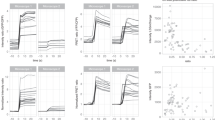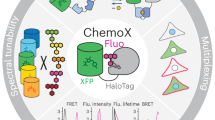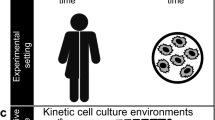Abstract
THE temporal and spatial dynamics of intracellular signals and protein effectors are being defined as a result of imaging using fluorescent reagents within living cells1–5. We have described a new class of fluorescent analogues2 termed optical biosensors6, which sense chemical or molecular events through their effects on protein transducers7. One example of this new class of indicators is MeroCaM, an environmentally sensitive fluorophore which when it is attached to calmodulin reflects the activation of calmodulin by calcium in vitro2. We report here that the rise in free calcium and MeroCaM activation occur in the same period during serum stimulation of quiescent fibroblasts. MeroCaM activation also correlates with the spatial pattern of increased free calcium and the contraction of transverse fibres during wound healing1, 8–10. Finally, migrating fibroblasts in the later stages of wound-healing exhibit an increasing gradient of free calcium and MeroCaM activation from the front to the rear.
This is a preview of subscription content, access via your institution
Access options
Subscribe to this journal
Receive 51 print issues and online access
$199.00 per year
only $3.90 per issue
Buy this article
- Purchase on Springer Link
- Instant access to full article PDF
Prices may be subject to local taxes which are calculated during checkout
Similar content being viewed by others
References
Kolega, J. & Taylor, D. L. Curr. Top. Membr. 38, 187–206 (1991).
Hahn, K. M., Waggoner, A. S. & Taylor D. L. J. biol. Chem. 265, 20335–20345 (1990).
Taylor, D. L. et al. Cell Structure and Function by Spectrofluorimetry (eds Kohen, E. & Hirschberg, J. G.) 297–313 (Academic, New York, 1989).
Tsien R. Y. Meth. Cell Biol. 30, 127–153 (1989).
Bright, G. R., Whitaker, J. E., Haugland, R. P. & Taylor, D. L. J. cell. Physiol. 141, 410–419 (1989).
Hahn, K. M. et al. Fluorescent Probes for Biological Function in Living Cells (eds, Mason, W. T. & Relf, G.) (Academic, London, in the press).
Adams, S. R., Haroontunian, A. T., Buechler, Y. J., Taylor, S. S. & Tsien, R. Y. Nature 349, 694–697 (1991).
Fisher, G. W., Conrad, P. A., DeBiasio, R. L. & Taylor, D. L. Cell Motil. Cytoskel. 11, 235–247 (1988).
Conrad, P. A., Nederlof, M. A., Herman, I. M. & Taylor, D. L. Cell Motil. Cytoskel. 14, 527–543 (1989).
DeBiasio, R. L., Wang, L., Fisher, G. W. & Taylor, D. L. J. Cell Biol. 107, 2631–2645 (1988).
Mills, J. S., Walsh, M. P., Nemcek, K. & Johnson, J. D. Biochemistry 27, 991–996 (1988).
Cohen, P. & Klee, C. (eds), Calmodulin (Elsevier, New York, 1988).
Bright, G. R., Fisher, G. W., Rogowska, J. & Taylor, D. L. Meth. Cell Biol. 30, 157–190 (1989).
Byron, K. L. & Villereal, M. L. J. biol. Chem. 264, 18234–18239 (1989).
Tucker, R. W. & Fay, F. S. Eur. J. Cell. Biol. 51, 120–127 (1990).
McNeil, P. L., McKenna, M. P. & Taylor, D. L. J. Cell Biol. 101, 372–379 (1985).
Berridge, M. J. J. biol. Chem. 265, 9583–9586 (1990).
Giuliano, K. et al. Cell Motil. Cytoskel. 16, 14–21 (1990).
Sellers, J. R. & Adelstein, R. S. The Enzymes XVIII, 381–418 (1987).
Sellers, J. R. Curr. Opin. Cell Biol. 3, 98–104 (1991).
Kamm, K. E. & Stull, J. T. A. Rev. Pharmac. Toxicol. 25, 593–620 (1985).
Taylor, D. L., Blinks, J. R. & Reynolds, G. T. J. Cell Biol. 86, 599–607 (1980).
Brundage, R. A. Fogarty, K. E., Tuft, R. A. & Fay, F. S. Science 254, 703–706 (1991).
Taylor, D. L., Nederlof, M., Lanni, F. & Waggoner, A. S. Am. Sci. 80, 322–335 (1992).
Luby-Phelps, K., Lanni, F. & Taylor, D. L. J. Cell Biol. 101, 1245–1256 (1985).
Zavortink, M. M., Welsh, M. J. & McIntosh, J. R. Expl Cell Res. 149, 375–385 (1983).
Author information
Authors and Affiliations
Rights and permissions
About this article
Cite this article
Hahn, K., DeBiasio, R. & Taylor, D. Patterns of elevated free calcium and calmodulin activation in living cells. Nature 359, 736–738 (1992). https://doi.org/10.1038/359736a0
Received:
Accepted:
Issue Date:
DOI: https://doi.org/10.1038/359736a0
This article is cited by
-
RAC1-Dependent ORAI1 Translocation to the Leading Edge Supports Lamellipodia Formation and Directional Persistence
Scientific Reports (2020)
-
Calcium signaling: breast cancer’s approach to manipulation of cellular circuitry
Biophysical Reviews (2020)
-
Collective cell migration has distinct directionality and speed dynamics
Cellular and Molecular Life Sciences (2017)
-
Ion Channels in Regulation of Neuronal Regenerative Activities
Translational Stroke Research (2014)
-
Migrating Oligodendrocyte Progenitor Cells Swell Prior to Soma Dislocation
Scientific Reports (2013)
Comments
By submitting a comment you agree to abide by our Terms and Community Guidelines. If you find something abusive or that does not comply with our terms or guidelines please flag it as inappropriate.



